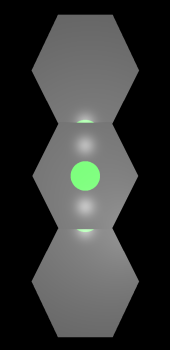
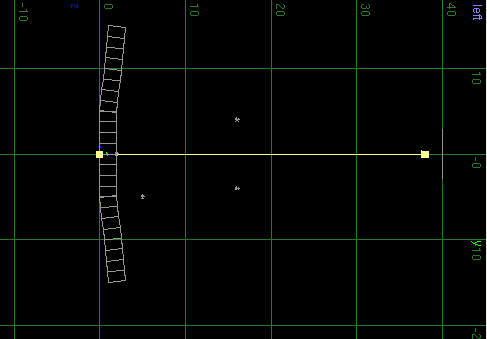
|
vm-cell-povgen
|
Sensors & Source Elements

|
This rendering shows 3 hex sensor cells, the top and bottom cells offset 6 degrees.
|
POV-Ray produces a very fine gradiant based on simulated photons shown in this GIMP shot.
"Lense" Heightfield Creation
Heightfield file initially generated from an actual POV-Ray CSG object: 2 intersecting spheres.

here is the union of 2 spheres
The convex forms are shown below render
|
/* sphere union */
/*
union {
sphere { <0, 0, 0>, 1
translate -0.75*x
}
sphere { <0, 0, 0>, 1
translate 0.5*x
}
pigment { rgb <.5,.5,.5> }
finish { reflection 1 }
rotate <15,-15,30>
}
*/
lense-union.pov (complete .pov file)
/* put the camera in front of the "ideal" lense dish */
camera { location <0,0,-3> look_at <0,0,0> angle 0 }
/* convex sphere intersection */
intersection {
sphere { <0, 0, 0>, 1
translate -0.75*x // greater, thinner, "wider" dish
}
sphere { <0, 0, 0>, 1
translate 0.5*x // greater, thinner, "wider" dish
}
pigment { rgb <.5,.5,.5> }
finish { reflection 1 }
rotate <15,-15,30> // rotate the CSG lense object to show the edges
}
light_source {
<0, 0, -10>, rgb <1, 1, 1>
spotlight
radius 50
falloff 40
tightness 95
point_at <0, 0, 0>
fade_distance 10 // determine brightness gradiant
fade_power 10
}
|
below is the straight on view of the lense used as a heightfield to create a concave form:
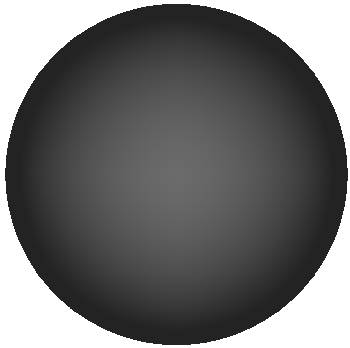
height field "lense1.gif" used in povray file
|
#include "shapes.inc"
#include "colors.inc"
#include "textures.inc"
/* put the camera in front of the "ideal" lense dish */
camera { location <0,0,-3> look_at <0,0,0> angle 0 }
height_field {
gif "lense1.gif"
pigment { rgb <0.2,0.2,0.2> }
rotate 90*x
scale <1.5, 1.5, 1.5>
finish { ambient 0.5 diffuse 0.5 reflection 0.15 specular 0.25 roughness 0.001 }
translate <-0.750, 0.50, 0>
}
light_source {
<0, 0, -10>, rgb <1, 1, 1>
spotlight
radius 70
falloff 70
tightness 25
point_at <0.0333333, 0.0333333, 0.0333333>
fade_distance 10
fade_power 10
}
lense-convex-heightfield.pov
| |

Rendering of lense-heightfield.pov: here your can see gradiant lines and the curved shapes created by caustic effects. |
"Flat" sensors can be titled to create lenses, even hardware such as CCD chips can be used in this method. Results can be simulated in vm-cell, and vm-cell-povgen.
|
Sensors are place inside the faces of a dymaxion or geodesic sphere |
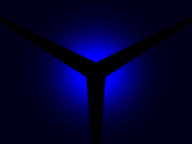
This rendering shows the juncture of 3 |
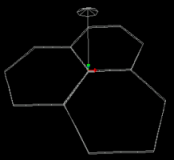
|
At one level or another all sensors are "flat"
Diameter of an electron: 2.817940285(31)-15m (this amount will vary depending on the amount of interaction)
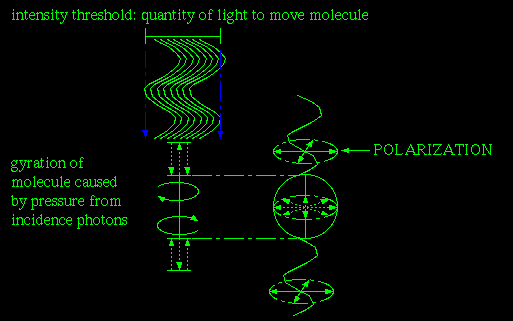
at this resolution photons can move sensor surface molecules depending on intensity and material type OE Reports: Photon angular momentum rotates molecules |
spherespin.pl ...in progress (a perl script to rotate and render spheres in pov based on 3spherescolor.pov file)
Sensor elements can be layered, aligned and moved in forms (ie. spinning spheres constructed using alternative geometry) that allow them to cover a lense shape over time. A major limitation is the turbulence of the source element. Layering, speed, and precision help counteract this. ...as discussed in the vm-cell 4D-Lense files a more accurate topology for a particular form and configuration "builds" over time.


pov-alt.geospheres:
This modular component uses POV-Ray to visualize and gtk+-pov to graph spinning alternative spherical forms (such as geodesic spheres). Applications include positioning & stabilization, as well as lighting effects with 4D Lense.

sensor characterisitics
type
resolution
material (frequency)
resonance
source elements (in example): 2 lights, green dish shown in rendering
source distance
source intensity
source frequency